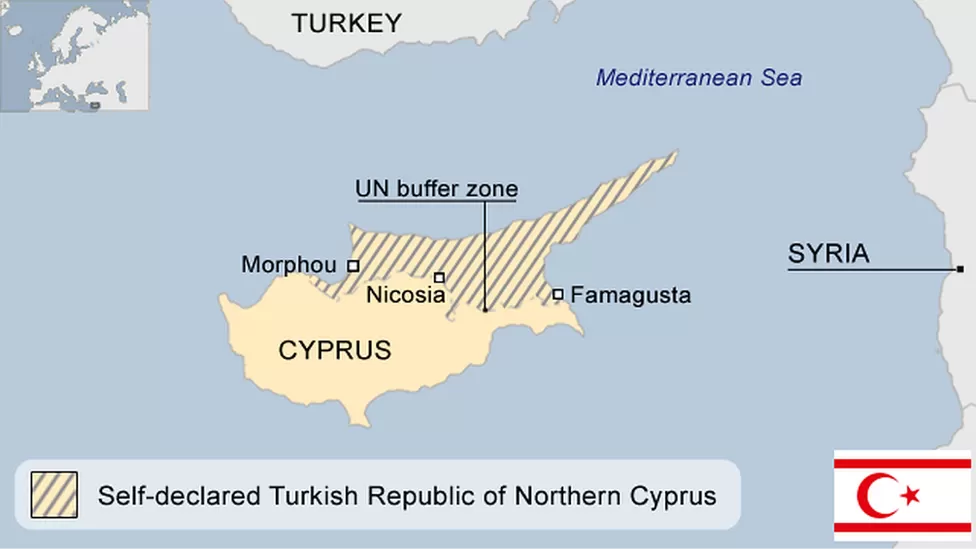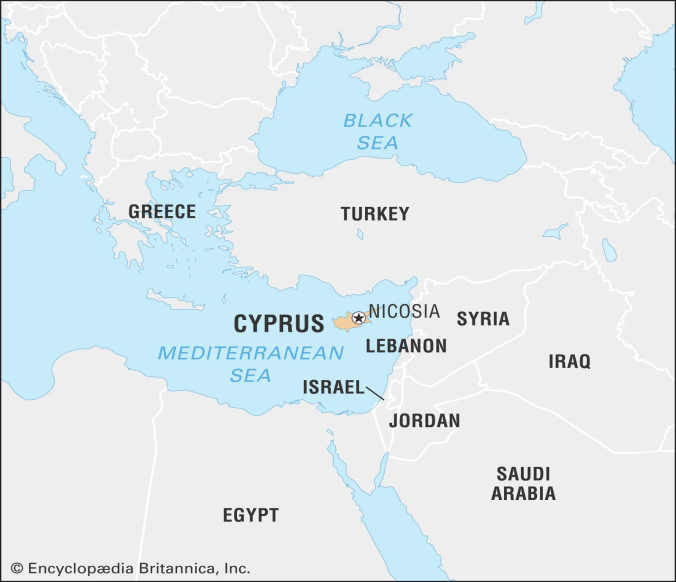Description

Copyright infringement not intended
Picture Courtesy: https://www.bbc.com/news/world-europe-17217956
Context: Cyprus has remained divided since the 1974 Turkish invasion, leading to a tense situation between the Greek Cypriot south and the Turkish Cypriot north. UN peacekeepers (UNFICYP) have been deployed for 60 years to uphold the ceasefire and manage the buffer zone that separates the two sides.
Key Points
Background
- Cyprus gained independence from Britain in 1960 with a constitution aiming for peace between the Greek Cypriot majority and the Turkish Cypriot minority.
- Inter-communal tensions escalated in 1963, leading to violence and the division of the capital, Nicosia, along the "Green Line."
- A 1974 Turkish invasion further divided the island, with the northern part declaring independence as Northern Cyprus (recognized only by Turkey).
UN Peacekeeping
- The United Nations Peacekeeping Force in Cyprus (UNFICYP) was established in 1964 to maintain peace and has been present ever since, with the UK as a key contributor.
- Peacekeepers patrol the buffer zone, a 180km strip separating the two sides, and monitor for unauthorized activity.
- Despite their presence, the buffer zone remains tense with frequent infringements like unauthorized crossings and illegal activities.
Challenges and Uncertainties
- The long-lasting division and failed reunification efforts raise questions about the effectiveness of the peacekeeping mission.
- Previous US pressure to review UN peacekeeping missions and the lack of progress raises concerns about the mission's future.
- The potential involvement of Greece and Turkey, both NATO members, adds another layer of complexity.
.jpg)
UN Peacekeeper
- United Nations peacekeeping is a unique and crucial aspect of the organization's efforts to maintain international peace and security. The concept of UN peacekeeping emerged in the aftermath of World War II and the establishment of the United Nations in 1945.
- The UN Charter grants the Security Council the authority to deploy peacekeeping missions to address conflicts and help countries transition to peace.
Key aspects of UN peacekeeping
- Mandate: UN peacekeeping missions operate under a specific mandate authorized by the UN Security Council. The mandate outlines the mission's objectives, scope of operations, and rules of engagement. It is crucial for the success of a peacekeeping mission and is subject to periodic review and renewal by the Security Council.
- Principles: UN peacekeeping is guided by several fundamental principles, including the consent of the parties involved, impartiality, and the non-use of force except in self-defence and defence of the mandate. The peacekeepers operate with the consent of the host country's government and any other parties involved in the conflict.
- Troop-contributing countries (TCCs): Member states of the United Nations contribute military and civilian personnel to serve as peacekeepers. These countries voluntarily offer their personnel and resources, and the contributions can include troops, police, and civilian experts. The TCCs play a crucial role in the effectiveness and success of a peacekeeping mission.
- Deployment: Once the mandate is established and troop-contributing countries identified, the peacekeeping mission is deployed to the conflict zone. The deployment involves a comprehensive planning process, considering logistics, security, and the specific requirements of the mission.
- Civilian and military components: UN peacekeeping missions usually include both civilian and military components. The civilian aspect may involve political affairs, human rights monitoring, humanitarian aid, and development efforts. The military component provides security, monitors ceasefires, and supports the political process.
- Peacebuilding and development: Beyond traditional peacekeeping, modern UN peacekeeping missions often involve elements of peacebuilding and development. This includes supporting institutions, fostering the rule of law, and promoting economic and social development to address the root causes of conflict.
Cyprus: An Island Nation
- Cyprus, officially the Republic of Cyprus, is an island country in the eastern Mediterranean Sea. While geographically located in Western Asia, its cultural and political ties are more closely linked to Southeastern Europe.
- As the third-largest island in the Mediterranean, Cyprus covers an area of roughly 9,251 square kilometres.
- Two mountain ranges dominate the island's landscape: Troodos Mountains occupying the central and southwestern parts, and the Kyrenia Range stretching along the northern coast. Mount Olympus, the highest point in Cyprus, sits within the Troodos Mountains at 1,952 meters.
- A vast central plain, known as the Mesaoria, separates the two mountain ranges.
- Since 1974, the island has been divided into two main parts:
- The southern part, the Republic of Cyprus, is internationally recognized.
- The northern part, the Turkish Republic of Northern Cyprus, is recognized only by Turkey.
- The Republic of Cyprus is a presidential republic, where the president serves as both head of state and head of government.
- Tourism is a major pillar of the Cypriot economy, the manufacturing sector is focused on products like food processing, chemicals, and pharmaceuticals.
- Cyprus produces a variety of agricultural products, including citrus fruits, olives, grapes, and vegetables.

|
PRACTICE QUESTION
Q. Which of the following bodies of water borders Cyprus?
A) Black Sea
B) Aegean Sea
C) Mediterranean Sea
D) Atlantic Ocean
Answer: C
Explanation: Cyprus is an island nation located in the eastern Mediterranean Sea, south of Turkey and west of Syria and Lebanon. The Aegean Sea lies further north of the island. The Black Sea is a separate body of water north of Turkey, and the Atlantic Ocean is on the other side of Europe.
|







